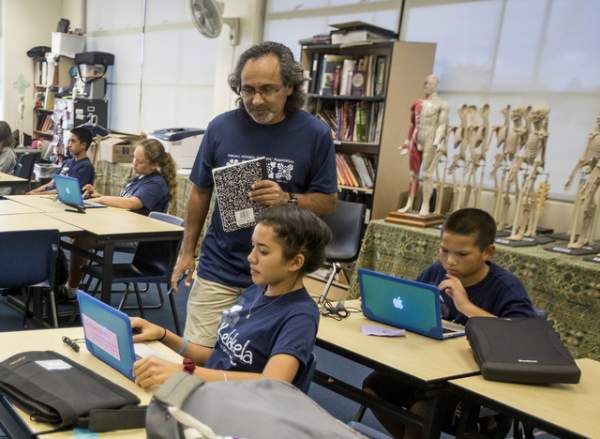The Hawaiʻi Tribune-Herald (HTH) and sister publication West Hawaiʻi Today (WHT) recently published a series called “The Concussion Conundrum”.
On the national level, concussions continue to be a prominent topic of discussion. Every Sunday during football broadcasts, at least one game deals with the fallout of injury due to a concussion. Hollywood movies have tried to tackle the subject and pending litigation and legislation continue to keep awareness high.
But while a lot of emphasis is placed on players paid to play the game, it’s important to look at what’s being done for students playing under the Friday night lights and how prevalent concussions are in other sports.
“My editor, David Bock, actually pitched it to me back in August; he wanted to do an in-depth sports story that went beyond the regular game recaps and player profiles,” shared HTH reporter Ivy Ashe.
“We had never written about concussions, which was a little bit of an oversight, since the first legislation has been around for four years. It worked out well that the legislature had just passed an updated bill right before we decided to do the series!”
In the series, KS Hawaiʻi trainers and safety procedures were frequently highlighted for their progress and actions taken to address the concussion issue.
Football was looked at particularly because of its visibility and well-known connection to the concussion issue.
Tribune-Herald sports reporter Matt Gerhart’s article “Kamehameha a trend-setter in concussion avoidance” details the specific steps head football coach Dan Lyons has taken to make sure KS Hawaiʻi doesn’t just abide by state guidelines regarding concussion protocol, but leads and adopts new practices that put safety first.
“I believe we’ve been a leader,” Lyons said. “We’ve seen the number of concussions or evaluations of concussions dramatically drop.”
Some of those efforts include stopping hitting drills during spring practice, being well-schooled in the Heads Up Football program and not letting players start noncontact conditioning until they’ve taken their baseline test. Efforts KS Hawaiʻi have adopted for years before they became the norm or law.
The concussion baseline test is one of the most critical steps in staying informed on how student-athletes progress due to a head injury.
Part three of the series, “Baseline testing key to revealing concussions”, showcased how KS extends the testing to include middle-school athletes as well, ahead of state guidelines.
KS Hawaiʻi athletic training supervisor Zeny Eakins was quoted throughout each piece in the series and was glad to see this important topic addressed. Awareness is key and how concussions are recognized should be clarified.
“Many times post-injury concussion symptoms may not be physical,” said Eakins. “Athletic trainers use several tools but ImPACT testing is a way to help measure cognitive function like concentration and memory. To have a baseline ImPACT score helps us better determine an injured student’s return to play plan.”
Eakins also highlighted the important role kumu play in making sure athletes take proper precautions.
“We also depend on the Teacher Observation Questionnaire,” shared Eakins.
“After a student is injured we send a questionnaire to all the student’s teachers. Questions include whether a teacher have observed a change in a recovering student’s demeanor or classroom habits. It also asks if teachers have observed any physical symptoms a student might have after suffering a head injury (i.e. squinting in class, being abnormally tired or clumsy).
“The hope to make sure we don’t miss any signs and the student makes a healthy return to the classroom and their sport.”
Looking to the future, Gerhart’s article “Rule changes, more advanced gear might be part of the solution” highlighted how the protocols KS Hawaiʻi have place priority on prevention. If injuries occur, the training staff makes the call on whether or not players should re-enter a game, not the coach.
While football has the largest volume of concussions in Hawaiʻi high school sports, it is not the only sport that comes with risk of concussions.
In her article “Beyond football: Concussions are tracked in wide range of youth sports”, Ashe discovered that the sport with the highest incident rate of concussions was actually girl’s judo.
“One of my biggest takeaways was that concussions can happen in just about any sport,” shared Ashe.
“It's not something you can ever get rid of completely, but you can definitely reduce risks and--just as important--raise awareness of what, exactly, a concussion is and what you should do after you have one. It seems like getting the word out about that has been the biggest leap schools have taken in the past several years.”
Links to the full HTH series and two support articles are below. Though you can read the full series on either the HTH or WHT websites by searching the article title (subscription may be requested/required):

Athletic trainer Jose Saucedo gives students directions as they take a concussion assessment test. Photo: Hollyn Johnson, Hawaiʻi Tribune-Herald.

HTH sports reporter Matt Gerhart recognizes KS Hawaiʻi’s efforts to stay ahead of player safety trends.

Kamehameha starting quarterback Kaimi Like’s experience in the concussion protocol highlighted in the article, “Rule changes, more advanced gear might be part of the solution” Photo: Hollyn Johnson, Hawaiʻi Tribune-Herald.
Related stories
Related photo galleries
TAGS
ks hawaii,
athletics,
football,
student safety,
mālama ola,
athletic trainers,
concussion protocol,
faculty staff,
16-17action1,
ksorg
CATEGORIES
Kaipuolono Article, Themes, Leadership, KS Organization, Hawaii Newsroom, KS Hawaii Home, Hawaii Athletics, Hawaii Middle School, Hawaii High School, Malama Ola, Newsroom, Campus Programs, Hawaii
Print with photos
Print text only










